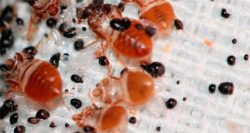Bedbugs are very small and can be found in the most inconspicuous places. A bedbug can fit conveniently into spaces with as little width as that of a business card. This is why many people find it difficult to detect bedbugs, and they keep seeking information on how to check for bedbugs.
This guide sheds light on how to check for bedbugs. That is the first step to take if you are going to effectively tackle the bed bug menace. Find out where bedbugs can be found and how to check for them.
COMMON HIDING SPOTS FOR BEDBUGS

Get a flashlight and an object that has a flat edge such as a paint scraper or credit card. Some of the places to check for bedbugs include beds, mattresses, couch and other furniture made from wood. The things that you should check out include bugs, eggs and feces. Also make sure you check all cracks, joints, crevices, bed sheet seams, holes in mattresses. Ensure you wear protective gloves while checking for bedbugs.
Check warm areas: Bedbugs enjoy warm places which is why they always lurk around in beds and mattresses. If you do not know how to check for bedbugs, look out for blood spots on your bed sheets and also check the tufts, folds and seams of your mattress. Also, check all the corners and crevices around your bed to be sure that no bedbug is lurking anywhere.
Check the perimeter of the rooms in your house. Bedbugs hide in corners, carpet and baseboard edges. One fact is that bedbugs are mostly found in places that you least expect them to be; so, leave no stone upturned.
LESS COMMON HIDING SPOTS FOR BEDBUGS
The treatment of bedbugs requires direct treatment which is why it is not enough to know how to treat them; you have to know how to check for bedbugs as well. It is crucial to know where you can find them and the places that they are likely not to be so that when you start treating your home for bedbugs, you will not end up wasting chemical or miss some of the bedbugs that can contribute to a more severe level of infestation.
Make use of flashlight alongside the object with a flat edge that you used earlier. Thoroughly inspect your dressers: nightstand and drawers. Open every drawer and check them out in details. Examine the joints and cracks of each drawer; turn them over and check beneath them to see if there is any bug hiding somewhere there.
Check out the curtains and drapes covering your windows and doors. Inspect the ceiling area, especially the corners. Check the back of loose wallpaper, beneath lamps, electronics, inside clocks, picture frames and any other item in your home that has enough space to harbor insects, animals and tiny pests. There are various approaches to handle bedbugs, but it is crucial to know how to check for bedbugs before anything else to avoid mistakes and ineffective cleaning. Click for Bedbug killers and control



